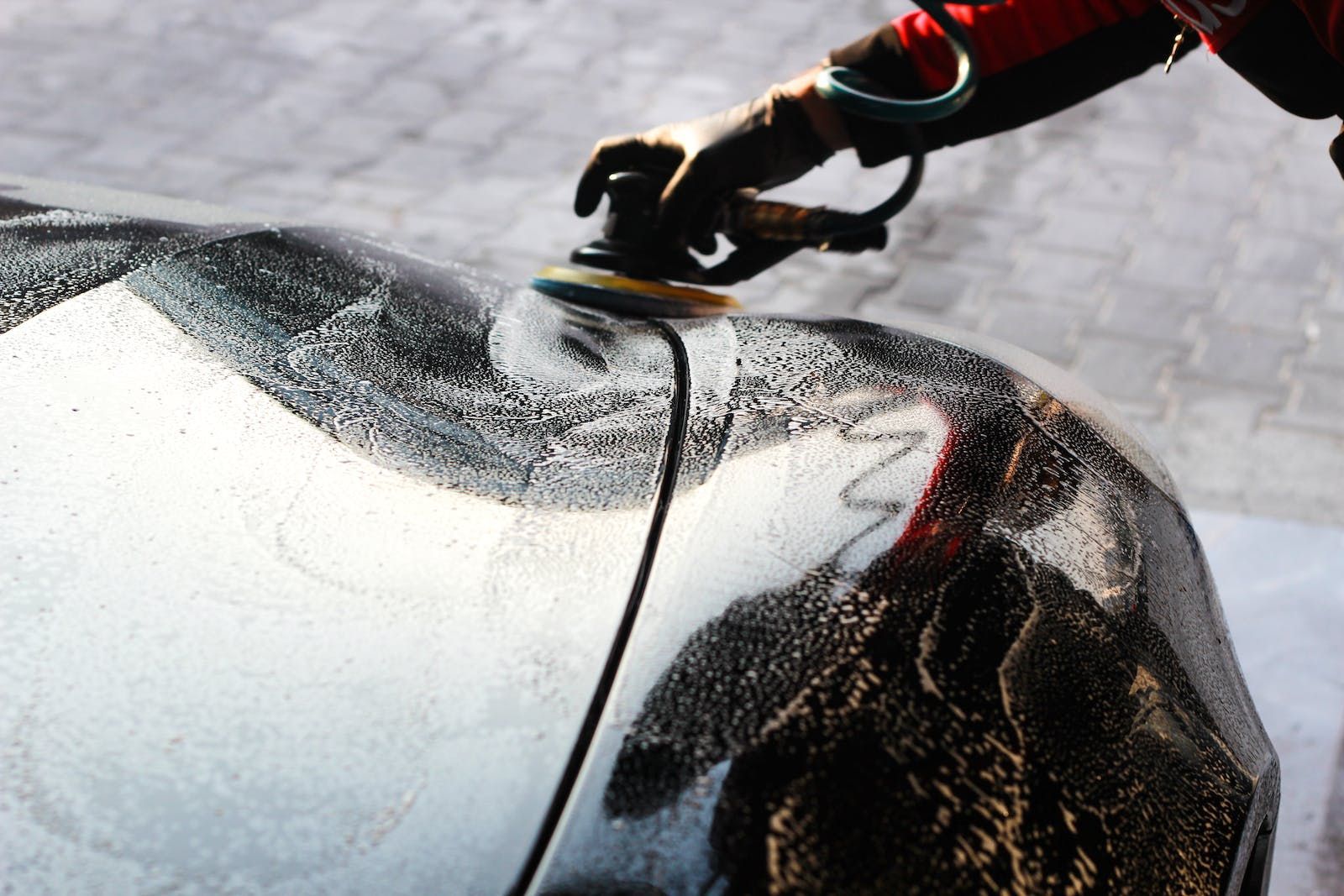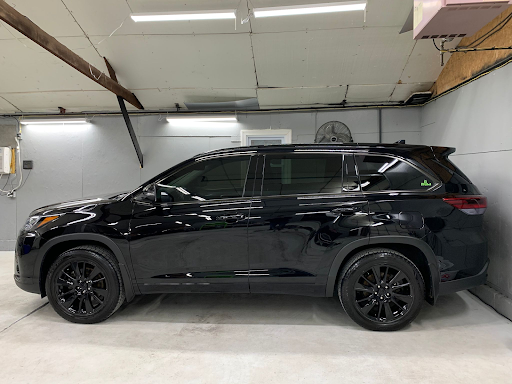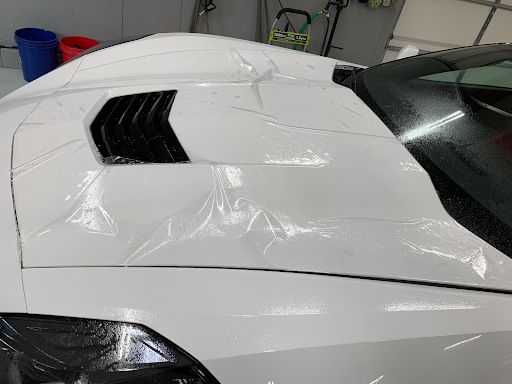When it comes to protecting and preserving your vehicle, ceramic coating has become an increasingly popular choice amongst car enthusiasts due to its impressive protection and shine-enhancing abilities. While ceramic coating has picked up popularity over the past few years, many still don’t really understand what it does, its benefits, or what the process actually entails.
Fortunately, for those curious about ceramic coating their vehicle, this guide will help clear up some of the mysteries surrounding ceramic coating and what it can do for you and your car.

What is Ceramic Coating?
Ceramic coating is a technologically advanced liquid polymer that is sprayed or wiped onto a vehicle’s exterior to form an incredibly strong, hydrophobic layer of protection. The coating creates a barrier between the paintwork and potential contaminants in the air—such as pollution, road grime, and bird droppings—to provide superior levels of protection that last up to five years.
The benefits of ceramic car coating are clear: it adds an extra layer of protection over your vehicle's paint job and makes washing and maintenance easier. But what about wax? Does ceramic coating replace wax completely? That’s where things can get complicated. On the one hand, they do have similarities; both are designed to protect against marks and scratches as well as provide an ultra-glossy finish.
On the other hand, ceramic coatings provide significantly better protection than waxes by forming a durable bond with your paintwork.
Ultimately, durability is the major advantage ceramic coating has over waxing. While wax does need to be applied regularly for maximum protection, you can expect ceramic-coated vehicles to maintain their protective layer for many months or even years at a time.
To decide whether it’s worth investing in ceramic coating for your car, it’s best to compare its cost and longevity with those of regular wax application.
It is clear that ceramic coatings can be an effective way of preserving your vehicle's paint job and protecting against harsh weather conditions and pollutants in the air, but there are still some important differences between them and waxes that should be considered before making a decision.
So now that we've discussed what ceramic coating is, let's take the next step and explore how it differs from traditional waxing methods.
How does it Differ from Waxes?
Ceramic coatings, which are often referred to as ceramic paints or paints that have been wear-resistant or scratch-resistant, are also made differently than waxes and offer better protection. Many people mistakenly assume that ceramic coatings and waxes achieve the same results, but this is an incorrect assumption because ceramic coatings provide much more protection than waxes.
The main difference between ceramic coatings and waxes is their durability. A ceramic coating will last much longer than a layer of wax, lasting up to five years on average, depending on the quality of the coating.
Waxes, on the other hand, typically need to be reapplied every three months to maintain their effectiveness. Ceramic coatings will also not degrade as quickly in direct sunlight as wax does, which makes them ideal for outdoor applications.
Moreover, ceramic coatings will produce a much more glossy shine than wax and can protect the paint from UV rays, mud, dirt, and other debris.
Ceramic coatings are also more expensive than good-quality natural carnauba wax and require professional application for the best results. However, despite the initial expense of installation, ceramic coatings give you longer-lasting protection that doesn’t need to be regularly maintained like regular waxes do.
The decision between a traditional wax product and a ceramic coating depends largely on your individual needs and preferences when it comes to vehicle paint care. Are you looking for long-term durability or short-term improvements? The choice should be based upon this question as well as other factors such as the level of gloss desired, environmental condition exposure levels, and budget considerations.
No matter what type of paint care you choose, though, it’s important to remember that both self-applied lubricants such as car wax and professionally applied protective films can help maintain your vehicle’s appearance, yet these products cannot replace proper maintenance habits like washing your car with the proper products and methods.
With this being said, understanding the advantages and disadvantages of all available solutions is key to making an informed decision about which one fits your situation best. From here, we can transition into discussing the advantages of ceramic coating and how investing in it provides multiple benefits, such as maintenance savings over time and improved aesthetics that maximize a car's value.
Advantages of Ceramic Coating
A major advantage of ceramic coating is that it can be more durable than wax. Ceramic coatings typically last between 18 and 36 months, and in some cases, even up to 5 years, while waxes will often only stay on the surface for a few months before needing to be reapplied.
Through their durability, ceramic coatings can be considered a much better financial investment in the long run. They have also been noted to provide higher protection against UV damage and water spots, providing an extra layer of protection compared to wax.
While there are almost unquestionable advantages when it comes to ceramic coating versus waxing, there are still issues related to the cost of maintenance and installation that may not make it the most ideal option for everyone.
With their significantly longer lifespan, ceramic coatings are generally more expensive to install and maintain due to their professional application. Waxing is a much simpler DIY process that puts less strain on both your wallet and your schedule for frequent application.
No matter what type of car detailing you choose, however, maintaining the longevity and good condition of your vehicle is essential for its value and performance. Taking into account the protection and aesthetic benefits of ceramic coating, it makes sense that this could be a worthwhile investment if you want something that will last longer than traditional waxing methods.
That being said, there are various factors to consider when deciding which type of solution is best suited for your particular needs. By properly researching these options and understanding the differences between them, you will be better placed to look at how ceramic coatings can improve aesthetics and offer better protection.
Improved Aesthetic and Protection
The advantages of ceramic coating include improved aesthetics and protection for covered surfaces. Aesthetically, a ceramic coating provides a glossy, vibrant look that is typically much more attractive than the look of bare or lightly coated surfaces without it.
It also helps to protect the vehicle’s paint from various environmental elements, making it resistant to fading from exposure to sunlight and other UV light sources. It also helps protect against dirt and debris as well as water spots, which can be especially damaging on darker paints. This protective layer not only helps preserve the exterior finish of your vehicle, but it also helps maintain its value over time.
On the flip side, some automotive enthusiasts argue that the glossy finish isn't always appealing since some people prefer a more matte look for their vehicles. Additionally, while a ceramic coating does offer significant protection against scratches and other minor damages, it will not necessarily prevent catastrophic damage such as deep scratches or dents that can occur in an accident.
Consequently, it is important to keep in mind that while ceramic coatings do provide a host of benefits, they should not be seen as an alternative to proper maintenance and care.
In any case, ceramic coatings are becoming increasingly popular due to their effectiveness in protecting and preserving vehicles' exteriors for both performance and aesthetic purposes. The longevity of this protection is further enhanced with regular maintenance, like waxing or polishing, which should be done every few months for optimal results.
With proper application and care, you should see decreased downtime due to repairs or repainting down the road, ultimately helping you maximize your investment in your vehicle. Now that we know what advantages can come from using ceramic coatings, let’s explore how they work specifically to protect our cars.
- A ceramic coating is more durable than wax, lasting two to five years, while wax usually lasts only a few months.
- Ceramic coatings form an impervious barrier on your paintwork that protects it from weather, road dirt, pollen, salt water, and acidic contaminants in the atmosphere.
- Waxing will only provide protection against minor daily wear and tear, while a professional ceramic coating goes much deeper into the paint to create a protective layer that lasts for years.
How Does Ceramic Coating Work?
Ceramic coatings are a type of protective layer that is applied to items such as cars, boats, and other vehicles. This protective coating works through a chemical bonding process that adheres to the surface of the object.
The process starts by cleaning the surface in order to ensure that there is no dirt or debris that would prevent the coating from effectively bonding to the item. From there, the technicians apply the ceramic coating, which forms a tough yet flexible barrier on the surface of the object. Once cured, this barrier provides a number of benefits for its longevity and protection.
The overall effectiveness of ceramic coating comes from its composition. Made mostly of SiO2 (silicon dioxide)—also known as silica or quartz—it allows for an extremely hard and durable finish that is resistant to physical damage and wear and tear caused by contact with elements like mud, salt water, and UV light.
Additionally, ceramic coatings are also hydrophobic, meaning they repel water instead of absorbing it, preventing any water-based damage to occur on your vehicle's bodywork or paint job.
When it comes to debating how effective ceramic coatings are in comparison to traditional methods like waxes, sealants, and polishes, there is clear evidence to suggest that they offer more protection than those methods due to their enhanced levels of durability and resistance against corrosion. Furthermore, ceramic coatings also last much longer than traditional products, with most lasting around two years.
To put this into perspective, a wax or polish typically only lasts around 6 months before needing to be reapplied due to fading or weathering damage. On top of this, removals are much simpler with ceramics when compared with waxes and polishes too, making them the preferred choice for many car owners looking for superior protection against daily wear and tear.
Benefits of Ceramic Coating
The benefits of ceramic coating are numerous, ranging from improved aesthetics to additional protection for surfaces. For cars, in particular, ceramic coating offers a great way to maintain and preserve the vehicle's exterior from various environmental factors that can cause damage. Here we'll discuss some of the advantages of ceramic coating, covering both sides of the argument where applicable.
Improved Aesthetic. One undeniable benefit of ceramic coating is its aesthetic boost to any given surface. This high-gloss finish helps make any car look newer and shinier for longer periods of time, even after many washings and exposure to the elements. The slick coating also repels dirt, dust, and contaminants, so your car will stay clean much easier. Plus, this layer helps to reduce odors while safeguarding paint finishes from UV damage.
Protection against damage. Ceramic coatings act as a barrier against potential damage like scrapes, scratches, acid rain, and other damaging particles that can erode the top layer of paint on vehicles over time. In addition, this protective coating resists water etching more effectively than traditional waxing products, which can be washed away if exposed to water outside their intended application window. Furthermore, it has been proven to provide protection against brake dust buildup on wheel surfaces as well as debris caused by bugs or dirt roads.
The only downside is that while it may be more affordable than paint protection film (PPF), professional installation is necessary in order to ensure a quality job that won't peel or chip prematurely. However, once properly applied by an experienced technician, it should last up to two years or more!

Protect Your Car's Paint with Our Professional Ceramic Coating Service
Are you tired of worrying about scratches, swirls, and other blemishes on your car's paint? Our professional ceramic coating service provides a long-lasting and durable solution to protect your car's paint from the elements, including UV rays, dirt, and debris.
At Prestige Auto Spa and Coatings, our experienced technicians use only the highest quality ceramic coatings, ensuring that your car's paint remains glossy and vibrant for years to come.
Don't wait any longer to give your car the best ceramic coating protection it deserves!
Contact us today at (717) 858-0453 to schedule your ceramic coating service.




